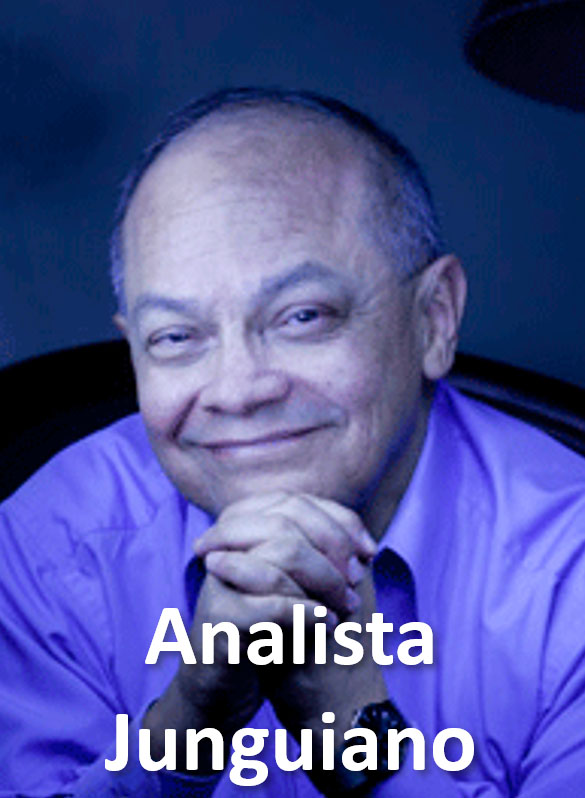Inglés
Bibliografía Temática en Inglés
No existen obras traducidas al castellano sobre todos los temas junguianos, por lo que es necesario recurrir a autores de habla inglesa. Por eso, relacionamos abajo obras clásicas en varios tópicos junguianos, con el objeto de complemantar la bibliografía castellana. Para eso, nos hemos ayudado de la excelente guíaA Guided Tour Of The Collected Works Of C.G. Jung, del autor norteamericano Robert H. Hopcke (1989), Editorial Random House Inc. Hopcke tiene la gran ventaja de recomendar los que en su concepto, son las mejores obras en cada tema, dejando a un lado los textos de CG Jung. Las categorías en las que organiza los libros son las siguientes: Arquetipos y lo Inconsciente Colectivo, Complejo, Libido, Sueños e interpretación de sueños, Símbolo, Imaginación activa, Psique / Alma, Espíritu, Eros y Logos / Masculino y femenino, Tipos psicológicos, Psicoterapia, Transferencia / Contra-transferencia, Individuación, Religión, Sincronicidad, Ego, Sombra, Persona (o máscara), Anima / Animus, Self (Sí-mismo), Madre, Padre, Puer / Divino niño, Core / La doncella, Héroe, Viejo sabio, Trickster, Coniunctio, Freud y el Psicoanálisis, Esquizofrenia, Desarrollo del niño y psicología, Amor y matrimonio, Fenómenos ocultos, Ovnis, Arte moderno y crítica de arte, Jung y alquimia, Psicología y alquimia, Misterium Coniunctionis, Aion.
ARQUETIPOS Y LO INCONSCIENTE COLECTIVO
Neumann, Erich (1995). The Origins and History of Consciousness. Princeton University Press
COMPLEJO
Dieckmann, Hans (1991). Complexes: Diagnosis and Therapy in Analytical Psychology. Illinois: Chiron Publications.
LIBIDO
Harding, Esther (1973. Pyche Energy: Its Source and Its Transformation. Princeton: Princeton University Press.
SUEÑOS E INTERPRETACIÓN DE SUEÑOS
Jung, C.G (1984). Dream Analysys: Notes of the Seminar Given in 1928-1930. Princeton: Princeton University Press.
Hall, James A. (1083). Jungian Dream, Interpretation: A Handbook of Theory and Practice. Toronto: Inner City Books.
SÍMBOLO
Visions: Notes of the Seminar Given in 1930-1934. 2 Vols. Claire Douglas, Ed., Princeton: Princeton University Press.
Adler, Gerhard (1961). The Living Symbol: A Case Study in the Process of Individuation. New York: Pantheon.
An Encyclopedia of Archetypal Symbolism:
Vol 1, Ed by Beverly Moon. Shambhala Publications, 1991, 1997
Vol 2, The Body, Ed by George Elder. Shambhala Publications, 1996.
IMAGINACIÓN ACTIVA
Adler, Gerhard (1961). The Living Symbol: A Case Study in the Process of Individuation. New York: Pantheon.
Johnson, Robert (1986). Inner Work: Usong Dreams and Active Imagination for Personal Growth. San Francisco: Harper and Row.
Kast, Verena (1993). Imagination as Space of Freedom: Dialogue between the Ego and the Unconscious. Translated by Anselm Hollo. New York: Fromm.
PSIQUE / ALMA
Von Franz, Marie-Louise (1981). Projection and Re-Collection in Jungian Psychology: Reflection of the Soul. London: Open Court.
Neumann, Erich (1956): Amor and Psyche: The Psychic Development of the Feminine. Princeton: Princeton University Press
ESPÍRITU
Campbell, Joseph (1954). Ed. Spirit and Nature: Papers from the Eranos Year-books. Princeton: Princeton University Press.
Kerenyi, Karl (1983). Apollo. Dallas: Spring Publications.
Eros y Logos / Masculino y femenino
Neumann, Erich (1956): Amor and Psyche: The Psychic Development of the Feminine. Princeton: Princeton University Pres
TIPOS PSICOLÓGICOS
Von Franz, Marie-louise y Hillman, James (1971).Lectures on Jung’s Typology. New York: Spring Publications.
Spoto, Angelo (1995). Jung’s Typology in Perspective. Evanston, III: Chiron Publication.
PSICOTERAPIA
Fordham, Michael (1978). Jungian Psychotherapy. New York: Wiley.
Singer, June (1972). Boundaries of the Soul. New York: Doubleday.
Stein, Murray (1984). Ed. Jungian Analysis. Boulder: Shambhala.
Kast, Verena (1992). The Dynamics of Symbols: Fundamentals of Jungian Psychotherapy. Trans by Susan A. Schwarts. New York: Fromm.
Kugler, Paul (1995). Ed. Jungians Perspectives on Clinical Supervision. Zurich: Daimon.
Bradway, Kay and McCoard, Barbara, Sandplay: The Silent Worlshop of the Psiche. London: Routledge.
TRANSFERENCIA / CONTRA-TRANSFERENCIA
Fordham, Michael (1978). Jungian Psychotherapy. New York: Wiley
INDIVIDUACIÓN
Jacobi, Jolande (1967). The Way of Individuation. New York: New American Library
Adler, Gerhard (1961). The Living Symbol: A Case Study in the Process of Individuation. New York: Pantheon.
Wheelwright, Jane H (1981). The Dead of a Woman. New York: St Martin’s Press
Carotenuto, Aldo (1981). The Vertical Labyrinth: Individuation in Jungian Psychology. Toronto: Inner City Books.
Bosnak, Robert (1989). Dreaming with an AIDS Patient. Boston: Shambhala Publications, Reissued by Delta in 1997 as Christopher’r Dreams: Dreaming and Living with AIDS.
RELIGIÓN
Edinger, Edward F (1992). Ego and Archetype: Individuation and Religious Function of the Psyche. Baltimore: Penguin Book. Boston: Shambhala Publications.
Edinger, Edward F (1987). The Christian Archetype: A Jungian Commentary on the Life of Christ. Toronto: Inner City Books.
Dourley, John (1984). The Illness that We Are. Toronto: Inner City Books.
Kluger, Rivkah (1995). Psyche in Scripture: The Idea of the Chosen People and Other Essays. Toronto: Inner City Books.
Spiegelman, J. Marvin (1991). Ed. Sufism, Islam and Jungian Psychology. Temple, Ariz: New Falcon Publications.
Spiegelman, J. Marvin (1993). Ed. Judaism and Jungian Psychology. Temple, Ariz: New Falcon Publications.
Spiegelman, J. Marvin (1991). Ed. Hinduism and Jungian Psychology. Temple, Ariz: New Falcon Publications.
Spiegelman, J. Marvin (1995). Ed. Catholicism and Jungian Psychology. Temple, Ariz: New Falcon Publications.
Spiegelman, J. Marvin (1996). Ed. Protestantism and Jungian Psychology. Temple, Ariz: New Falcon Publications.
SINCRONICIDAD
Bolen, Jean Shinoda (1979). The Tao of Psychology: Synchronicity and the Self. San Francisco: Harper & Row.
Aziz, Robert (1990). C.G. Jung’s Psychology and Synchronicity. Albany: State University of New York Press.
EGO
Edinger, Edward F (1992). Ego and Archetype: Individuation and Religious Function of the Psyche. Baltimore: Penguin Book. Boston: Shambhala Publications.
Neumann, Erich (1995). The Origins and History of Consciousness. Princeton University Press.
SOMBRA
Von Franz, Marie-Louise (1995). Shadow and Evil in Fairy Tales. Dallas: Spring Publications. Boston: Shambhala Publications.
Von Franz, Marie-Louise (1971). “The Inferior Function”. In Von Franz M-L and Hillman, J. Jung’s Typology. New York: Spring Publication.
Sanford, John (1987). The Shadow Side of Reality. New York: Cross-road Press.
PERSONA (o máscara)
Jacobi, Jolande (1976). Masks of the Soul. Grand Rapids, Mich.: William B. Eerdmans.
Hopcke, Robert H. (1995). Persona: Where Sacred Meets Profane. Boston: Shambhala Publications.
ANIMA / ANIMUS
Jung, Emma (1957). Animus and Anima. New York: Spring Publications.
Brunner, Cordelia (1986). Anima as Fate. Dallas: Spring Publications.
Hillman, James (1985). Anima: The Anatomy of a Personified Notion. Dallas: Spring Publications.
Ulanov, Ann y Ulanov Barry (1994). Transforming Sexuality: The Archetypal World of Anima and Animus. Boston: Shambhala Publications.
SELF (SÍ-MISMO)
Edinger, Edward F (1992). Ego and Archetype: Individuation and Religious Function of the Psyche. Baltimore: Penguin Book. Boston: Shambhala Publications.
Edinger, Edward F (1986). Encounter with the Self: A Jungian Commentary on William Blake’s “Illustrations of the Book of Job”. Toronto: Inner City Books.
Edinger, Edward F (1992). The Transformation of the God – Image: An Elucidation of Jung’s Answer to Job. Toronto: Inner City Books.
Jacobi, Mario (1980). Longing for Paradise: Psychological Perspective on Archetype. Boston: Sigo Press.
Von Franz, Marie-Louise (1997). Archetypal Dimensios of the Psyche. Boston: Shambhala Publications.
MADRE
Harding, Esther (1965). The Parental Image: Its Injury and Reconstruction. New York: Putnam.
Ulanov, Ann (1971). The Feminine in Jungians Psychology and Christian Theology. Evanston, III: Northwestern University Press.
PADRE
Samuels, Andrew (1988). The Father: Contemporany Jungian Perspectives. New York: New York University Press.
Perry, John Weir (1966). Lord of the Four Quarters: Myths of the Royal Father. New York: Braziller.
Colman, Arthur and Colman, Libby (1988). The Father: Mythology and Changing Roles. Chicago: Chiron.
Monick, Eugene (1994). Phallos: Símbolo sagrado de la masculinidad. Santiago de Chile: Cuatro Vientos Editorial.
PUER / DIVINO NIÑO
Hillman, James et al (1979). Puer Papers. Dallas: Spring Publications.
Core / La doncella
Brinton-Perera, Sylvia (1981). Descent to the Goddess: A Way of Initiation for Women. Toronto: Inner City Books.
Wilkinson, Tanya (1996). Persephone Returns: Victims, Heroes and the Journey from the Underworld. Berkeley, Calif: Pagemill Press.
HÉROE
Chinen, Allan (1993). Beyond the Hero: Classic Stories of Men in Search of Soul. Los Angeles: Tarcher.
Neumann, Erich (1995). The Origins and History of Consciousness. Princeton University Press.
VIEJO SABIO
Von Franz Marie-Louise (1980). Individuation in Fairly Tales. Dallas: Spring Publications.
TRICKSTER
Kerényi, Karl (1987). Hermes, Guide of Soul. Dallas: Spring Publicationns.
Chinen, Allan (1993). Beyond the Hero: Classic Stories of Men in Search of Soul. Los Angeles: Tarcher.
Malokti, Ekkehart and Lomatuway’ma, Michael (1984).Hopi Coyote Tales: Instututwutsi. Lincoln: University of Nebraska Press.
Haile, Fr. Bernard (1984). Navajo Coyote Tales: The Curly Tó Aheedlíni Version. Lincoln: University of Nebraska Press.
CONIUNCTIO
Stein, Robert (1973). Incest And Human Love: The Betrayal of the Soul in Psychotherapy. New York: The Third Press.
Schwartz-Salant, Nathan and Stein, Murray (1984). Eds. Chiron: A Review of Jungian Analysis.
Edinger, Edward (1994). The Mystery of the Coniunctio: Alchemical Image of Individuation. Toronto: Inner City Books.
FREUD Y EL PSICOANÁLISIS
McGuire, William, Ed. (1974). Correspondencia: Sigmund Freud, Carl Jung. Madrid: Taurus Ediciones.
ESQUIZOFRENIA
Perry, John Weir (1953). The Self in Psycotic Process. Dallas: Spring Publications.
Perry, John Weir (1974). The Far Side of Madness. Englewood Cliffs, N.Y.:Prentice-Hall.
Killic, Katherine and Schaverien, Jay (1997). Eds.Psychoterapy and Psychosis. London: Routledge, 1997.
DESARROLLO DEL NIÑO Y PSICOLOGÍA
Kalff, Dora (1980), Sandplay: A Psychotherapeutic Approach to the Psyche. Boston: Sigo Press.
Wickes, Frances (1988). The Inner World of Childhood. 3° Ed. Boston: Sigo Press.
AMOR Y MATRIMONIO
Guggenbühl-Craig, Adolf (1977). Marriage – Dead or Alive. Dallas: Spring Publications.
Young-Eisendrath, Polly (1984). Hags and Heroes: A Feminist Approach to Couple Psychotherapy. Toronto: Inner City Books.
Leonard, Linda (1986). On the Way to the Wedding. Boston: Shambhala.
Desteian, John (1988). Coming Apart / Coming Together: The Union of Opposites in Love Relationships. Boston: Sigo Press.
FENÓMENOS OCULTOS
Jaffé, Aniela (1979). Apparitions: An Archetypal Approach to Death Dreams and Ghosts. Dallas: Spring Publications.
OVNIS
Jaffé, Aniela (1979). Apparitions: An Archetypal Approach to Death Dreams and Ghosts. Dallas: Spring Publications.
ARTE MODERNO Y CRÍTICA DE ARTE
Neumann, Erich (1959). Art and Creative Unconscious. London: Routledge & Kegan Paul.
Neumann, Erich (1979). Creative Man. Princeton: Princeton University Press.
Barnaby, Karen y D’Acierno, Pellegrino (1990). C.G. Jung and the Humanities: Toward a Hermeneutics of Culture. Princeton: Princeton University Press.
Philipson, Morris (1994). An Outline of Jungian Aesthetics. Boston: Sigo Press.
Psychological Perspectives: A Semi-Annual Review of Jungian Thought, C.G. Jung Institute of Los Angeles.
Quadrant, Semi-Annual, C.G. Jung Funtation, New York.
The San Francisco Jung Institute Library Journal.
Spring.
PSICOLOGÍA Y ALQUIMIA
Jung, C.G. (1984). Dream Analysis: Notes of the Seminar Given in 1928-1930. Princeton: Princeton University Press.
Edinger, Edward (1990). Anatomia da Psique: O Simbolismo Alquímico na Psicoterapia. Sao Paulo: Editora Cultrix.
MISTERIUM CONIUNCTIONIS
Edinger, Edward (1995). The Misterium Lectures: A Journey through C.G. Jung’s Mitsreium Coniunctionis.Totonto: Inner City Books.
AION
Edinger, Edward (1996). The Aion Lectures: Exploring the Self in C.G. Jung’s Aion. Toronto: Inner City Books.























Para comentar debe estar registrado.